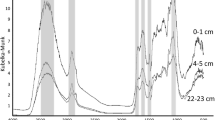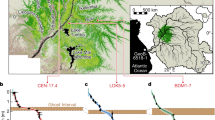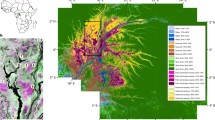Abstract
Using210Pb-dating of peat cores, corroborated by pollen and acid-insoluble ash approaches, rates of vertical height growth, dry mass accumulation, and organic matter accumulation were determined for fiveSphagnum-dominated peatland sites (one in Minnesota, one in Pennsylvania, one on the Maryland/West Virginia border, two in West Virginia), spanning a mean annual temperature range of 4.5 °C and differing in total annual precipitation by a factor of almost 2. Site differences in rates of vertical height growth and dry mass accumulation were documented, but both within-core and between-site differences in bulk density and ash concentrations of peat confound efforts to relate vertical height growth and dry mass accumulation to net organic matter accumulation. Taking bulk densities and ash concentrations into account, rates of net organic matter accumulation over the past 150–200 years were strikingly similar at four of the five sites, an unexpected result given the general trend that with decreasing latitude, peat deposits become older, thinner, and more highly decomposed. More comprehensive studies are needed in which net organic matter accumulation is determined at several locations within a single peatland, at several peatlands within a particular geographic/climatic region, and at peatland sites in different geographic/climatic regions. If additional studies confirm that recent (past 200 years) net organic matter accumulation is relatively insensitive to broad-scale regional climatic differences, boreal and subarctic peatlands may continue to function as a net sink for atmospheric CO2 and a net source of atmospheric CH4 with no change in rates of net organic matter accumulation, even under predicted scenarios of global climate change.
Similar content being viewed by others
References
Appleby, P. G. & F. Oldfield, 1978. The calculation of210Pb dates assuming a constant rate of supply of unsupported210Pb to the sediment. Catena 5: 1–8.
Armentano, T. V. & P. Verhoeven, 1985. The contribution of fresh-water wetlands to the global biogeochemical cycles of carbon, nitrogen, and sulfur, SCOPE26, John Wiley & Sons, N.Y.
Arnold, J. R. & W. F. Libby, 1951. Radiocarbon dates. Science 113: 111–120.
Braun, E. L., 1950. Deciduous forests of eastern North America. Hafner Press, N.Y., 596 pp.
Cameron, C. C., 1968. Peat. In Mineral Resources of the Appalachian Region, U.S. Geol. Surv. Prof. Pap. 580: 136–145.
Cameron, C. C., 1970. Peat resources of the unglaciated uplands along the Allegheny structural front in West Virginia, Maryland, and Pennsylvania. U.S. Geol Surv. Prof. Pap. 700D: D153-D162.
Clymo, R. S., 1984. The limits to peat bog growth. Phil. Trans. R. Soc., Lond. B303: 605–654.
Cole, K. L., D. R. Engstrom, R. P. Futuyma & R. Stottlemyer, 1990. Past atmospheric deposition of metals in northern Indiana measured in a peat core from Cowles Bog. Envir. Sci. Technol. 24: 543–549.
El-Daoushy, F., K. Tolonen & R. Rosenberg, 1982. Lead-210 and moss increment dating of two FinnishSphagnum hummocks. Nature 296: 429–431.
Faegri, K., P. E. Kaland & K. Krzywinski, 1989. Textbook of pollen analysis, Fourth ed., John Wiley, Chichester, 328 pp.
Fenneman, N., 1938. Physiography of eastern United States. McGraw-Hill, N.Y.
Fite, G. C., 1966. The farmers' frontier. Histories of the American frontier, Holt, Rinehart and Winston, N.Y., 272 pp.
Fletcher, S. W., 1955. Pennsylvania agriculture and country life, 1840–1940. Pennsylvania Historical and Museum Commission, Harrisburg, PA, 619 pp.
Gorham, E., 1991. Northern peatlands: Role in the carbon cycle and probable responses to climatic warming. Ecol. Applic. 1: 182–195.
Grigal, D. F., 1985.Sphagnum production in forested bogs of northern Minnesota. Can. J. Bot. 63: 1204–1207.
Grotch, S. L. & M. C. MacCracken, 1991. The use of general circulation models to predict regional climatic change. J. Climatol. 4: 286–303.
Hough, A. F., 1945. Frost pocket and other microclimates in forests of the Allegheny Plateau. Ecol. 26: 235–250.
Houghton, J. T., G. J. Jenkins & J. J. Ephraums, 1990. Climate change: the IPCC scientific assessment. Cambridge University Press, Cambridge.
Keever, C., 1953. Present composition of some stands of the former oak-chestnut forest in the southern Blue Ridge Mountains. Ecol. 34: 44–54.
Lang, G. E. & M. A. Topa, 1982. Solution chemistry of stream and surface waters in Cranesville Swamp. In B. R. McDonald (ed.), Proceedings of the Symposium on Wetlands of the Unglaciated Appalachian Region, West Virginia University Press, Morgantown, WV: 55–62.
Maxwell, J. A. & M. B. Davis, 1972. Pollen evidence of Pleistocene and Holocene vegetation of the Allegheny Plateau. Maryland. Quat. Res. 2: 506–530.
McDonald, B. R., 1985. Wetlands of West Virginia: Location and classification. West Virginia Heritage Wildlife/Heritage Data Base, West Virginia Dept. of Natural Resources, Elkins, WV.
Miller, P. C. (ed.), 1981. Carbon balance in northern ecosystems and the potential effect of carbon dioxide induced climate change. CONF-8003118, U.S. Dept. of Energy, Office of Health and Environmental Effects, Washington, D.C.
NOAA, 1985. Climatological Data, Annual Summaries Grand Rapids, MN, Freeland, PA, Oakland, MD and Bayard, WV. Environmental Data and Information Center, National Climatic Center, Asheville, NC.
Ohlson, M & B. Dahlberg, 1991. Rate of peat increment in hummock and lawn communities on Swedish mires during the last 150 years. Oikos 61: 369–378.
Ovenden, L., 1990. Peat accumulation in northern wetlands. Quat. Res. 33: 377–386.
Post, W. M. (ed.), 1990. Report of a workshop on the climate feedbacks and the role of peatlands, tundra, and boreal ecosystems in the global carbon cycle, ORNL/TM-11457, Oak Ridge National Laboratory, Oak Ridge, TN, 32 pp.
Robinette, S. L., 1964. Plant ecology of an Allegheny Mountain Swamp. M.S. thesis, West Virginia University, Morgantown, WV.
Salstrom, P., 1990. The agricultural origins of economic dependency, 1840–1880. In R. D. Mitchell (ed.), Appalachian Frontiers: Settlement, Society & Development in the Preindustrial Era. University Press of Kentucky, Lexington, KY: 261–283.
Sanguinetti, E. L. 1992. Characterization of the vegetation patterns of two adjacentSphagnum-dominated wetlands in the glaciated Pocono Plateau section of northeastern Pennsylvania. M.S. Thesis, Villanova University, Villanova, PA, 90 pp.
Schell, W. R., 1987. A historical perspective of atmospheric chemicals deposited on a mountaintop peat bog in Pennsylvania. Int. J. Coal Geol. 8: 147–173.
Spear, R. W. & W. G. Miller, 1976. A radiocarbon dated pollen profile from the Allegheny Plateau of New York State. J. Arnold Arboretum 57: 369–403.
Thompson, G. B., 1974. A history of the lumber business at Davis, West Virginia 1885–1924. McClain Printing Co., Parsons, W.V., 54 pp.
Urban, N. R, 1983. The nitrogen cycle in a forested bog watershed in northern Minnesota. M.S. thesis, University of Minnesota, 359 pp.
Urban, N. R., S. J. Eesenreich & D. F. Grigal, 1989. Sulfur cycling in a forestedSphagnum bog in northern Minnesota. Biogeochem. 7: 81–109.
Urban, N. R., S. J. Eisenreich, D. F. Grigal & K. T. Schurr, 1990. Mobility and diagenesis of Pb and210Pb in peat. Geochim. Cosmochim. Acta 54: 3329–3346.
Verry, E. S., 1975. Streamflow chemistry and nutrient yields from upland-peatland watershed in Minnesota. Ecol. 56:1149–1157.
Verry, E. S. & D. R. Timmons, 1982. Waterborne nutrient flow through an upland-peatland watershed in Minnesota. Ecol. 63: 1456–1467.
Walbridge, M. R., 1982. Vegetation patterning and community distribution in four high-elevation headwater wetlands in West Virginia. M.S. thesis, West Virginia University, Morgantown, WV, 167 pp.
Walbridge, M. R., 1994. Plant community composition and surface water chemistry of fen peatlands in West Virginia's Appalachian Plateau. Wat. Air Soil Pollut., in press.
Walter, H., 1985. Vegetation of the Earth and Ecological Systems of the Geo-biosphere, third edition. Springer-Verlag, Berlin, 318 pp.
Watts, W. A., 1979. Late Quaternary vegetation of central Appalachia and the New Jersey coastal plain. Ecol. Monog. 49: 427–469.
Widner, R. R., 1965. Forests and Forestry in the American States, a Reference Antholoy. American Association of State Foresters, 594 pp.
Wieder, R. K., 1985. Peat and water chemistry at Big Run Bog, a peatland in the Appalachian Mountains of West Virginia, U.S.A. Biogeochem. 1: 277–302.
Wieder, R. K. & G. E. Lang, 1983. Net primary production of the dominant bryophytes in aSphagnum-dominated wetland in West Virginia. The Bryologist 86: 280–286.
Wieder, R. K & G. E. Lang, 1986. Influence of wetlands and coal mining on stream water chemistry. Wat. Air Soil Pollut. 23: 381–396.
Wieder, R. K, A. M. McCormick & G. E. Lang, 1981. Vegetational analysis of Big Run Bog, a nonglaciatedSphagnum bog in West Virginia. Castanea 46: 16–29.
Author information
Authors and Affiliations
Additional information
This publication is the third paper in a series of papers presented at the session on ‘Past Climatic Change and the Development of Peatlands’ at the ASLO and SWS Meetings in Edmonton, Canada, May 30–June 3, 1993. Dr P. Kuhry and Dr S. C. Zoltai are serving as Guest Editors.
Rights and permissions
About this article
Cite this article
Wieder, R.K., Novák, M., Schell, W.R. et al. Rates of peat accumulation over the past 200 years in fiveSphagnum-dominated peatlands in the United States. J Paleolimnol 12, 35–47 (1994). https://doi.org/10.1007/BF00677988
Received:
Accepted:
Issue Date:
DOI: https://doi.org/10.1007/BF00677988




